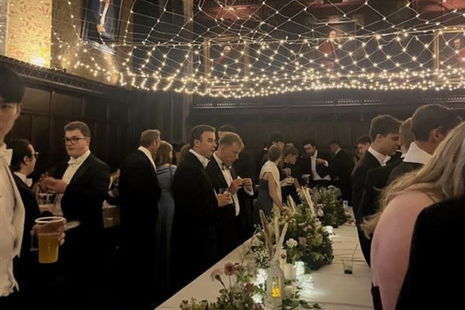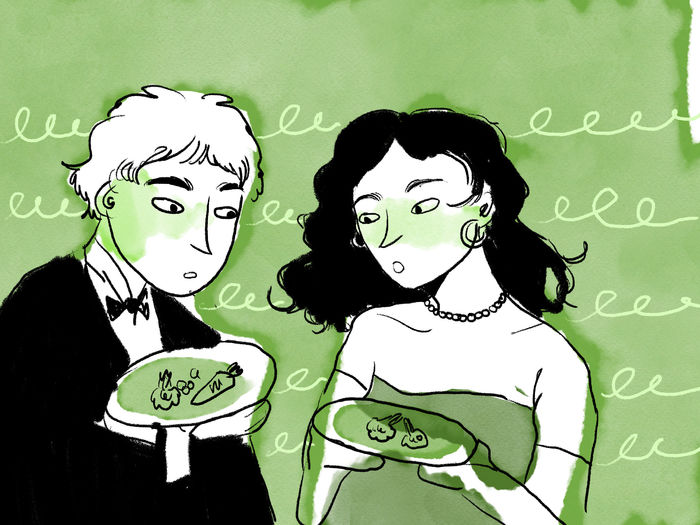White tie May Balls: tradition, prestige, and the cost of elegance
Sofía Sommerschield Torres uncovers the unique nature of Cambridge’s white tie May Balls, and the way some students have to prepare for it

Tailcoats, bow ties, floor-length gowns, and silk gloves. These were everywhere one looked when entering the Deer Park, the Peterhouse gardens encircling the Fitzwilliam Museum on Trumpington Street. Last Friday saw Peterhouse open its doors to partygoers for another May Ball season, organised biennially with an optional, but preferred, white tie dress code.
Peterhouse is one of only two colleges that enforce this dress code, the other being Magdalene. This May Ball tradition began at Peterhouse in 1892 – when the ball replaced the traditional termly concert – marking a significant shift in the College’s social calendar. The Grayling, a publication from Cambridge, described the preparations for this inaugural event, highlighting the College’s commitment to creating a memorable experience. A key feature mentioned was the decision to illuminate the gardens with electric light, a relatively novel and technologically advanced choice for the time. As the oldest college in Cambridge, Peterhouse is renowned for its rich history and commitment to long-standing traditions. It is not surprising, then, that the May Ball dress code aligns with the College’s historical penchant for tradition and prestige.
“For many, the opportunity to experience the grandeur and tradition of the Peterhouse May Ball justifies the expenditure”
For those attending the Peterhouse May Ball and looking to adhere to the white tie dress code, the option to hire full white tie suits offered a practical solution. The college partnered with a local company, James of Ely, to provide a heavily discounted white tie hire service for its guests. At a price of £90, including coverage for accidental damage, it was significantly more affordable than purchasing a brand new white tie ensemble. However, when combined with the price of a May Ball ticket, which is set at £235, the total cost for attendees began to add up. For many, the opportunity to experience the grandeur and tradition of the Peterhouse May Ball justifies the expenditure; the white tie dress code enhances the event’s prestigious atmosphere.
Within Peterhouse, 170 people hired their suits from James of Ely. That’s what Jack Matthews, a second-year law student, did. He explained: “I tried earlier to purchase vintage pieces second-hand, but they didn’t really fit properly, especially since the cuts of the suits used to be so different.” He had looked at a place called Victory Vintage, as well as eBay, but eventually opted to hire the suit.
Tommy Buckley acquired most of his white tie attire from eBay. His decision to choose second-hand pieces was driven by both cost-effectiveness and long-term savings, and ended up costing him £140. As an AMES student, Buckley reasoned that owning rather than renting will ultimately be more economical as he will be attending another Peterhouse May Ball in 4th year.
For those opting to wear dresses, the increased cost of the white tie dress code forces some students to be creative to meet the ball’s requirements. This was the case for Alannah Smyth, a second-year law student. She qualified for the bursary ticket, but with it only being £40 cheaper than the standard price, she was hesitant to spend additional money on a white tie floor-length gown. Determined to find a cost-effective solution, Smyth decided to make her own dress. She purchased fabric from Vinted which she could cut up and repurpose. She humorously noted to me that she procrastinated by sewing throughout the term and even during exam periods. “It was almost like a productive distraction from exam stress,” she explained.
In addition to dresses, some women at the ball found budget-friendly ways to complete their white tie ensembles. Several attendees confessed that they had purchased their gloves from Amazon for just five pounds. Though not particularly sustainable, this fashion choice shows that affordable options are indeed available for attendees of formal events like a May Ball.
“The more balls you attend, the more you realise that it’s not that deep. Lots of people thrift and get second-hand dresses”
Despite the prevalence of the Amazon gloves, a fair number of attendees at the white tie ball opted for a sustainable approach to their formal attire. Grace White and Holly Dutton, two third-year law students, acquired their dresses from Vinted – an online marketplace and community dedicated to buying, selling, and swapping second-hand fashion items. Dutton shared her experience: “The more balls you attend, the more you realise that it’s not that deep. Lots of people thrift and get second-hand dresses. All of my dresses this year were either from Vinted or passed down from family members because I spent too much on my dress last year. I realised how stupid that was because I didn’t really have the funds to spend on one dress.” By opting for second-hand dresses, Dutton and others are demonstrating that you can adhere to dress codes without compromising on sustainability or budgets.
The white tie dress code at the Peterhouse May Ball certainly elevated the event, adding a layer of sophistication and elegance to the night. Attendees, adorned in their finest attire, contributed to an atmosphere of grandeur that made the occasion truly memorable. Clemmie Lawlor highlighted the appeal of the white tie dress code, stating: “White tie dress code is cool because you can go a bit more extra without feeling like you’re overdressed. It’s a good excuse to dress up fancy and I felt really fun and glamorous on the night.”
However, while the Peterhouse May Ball and the white tie dress code add a touch of splendour to the event, they also bring certain challenges, especially for students from lower-income backgrounds. Smyth shared her feelings of discomfort and alienation: “Coming from a low-income background, the pressure to wear white tie made me feel like I was playing dress-up. On our way there in our gowns I felt quite silly, like it was Mufti Day at school, wondering if I’d be the only one dressed up. Once I was there and everyone was dressed up, it was actually really fun, but as soon as it started getting lighter, like at about 4am, I felt like I was in a costume again.” Smyth’s perspective highlights the very real experience many students share of feeling inauthentic or out of place during May Week and at various other formal events in Cambridge.
Dutton also pointed out the financial strain that May Balls can impose on students from less privileged backgrounds. Peterhouse is the third most expensive ball. “Price-wise, I think it’s definitely an issue and should be looked into for bursaries and things like that, especially for students who are from lower privileged backgrounds like myself.” She explained that it takes her a while to recuperate the funds that she’s spent at May Balls in the summer when she has to work her part-time job.
May Week, in general, can be a time of mixed emotions for many students. The high costs associated with attending multiple balls and the pressure to conform to formal dress codes can create barriers for those from lower-income backgrounds. While the events are celebrated for their elegance and enjoyment, they can also highlight socioeconomic disparities among students.
The consensus seems to be that the experience of participating in one of Cambridge’s most traditional and elegant celebrations often makes Peterhouse May Ball a worthwhile investment for guests. However, steeply priced at £235 – plus the additional cost to acquire the correct attire – emphasise the financial commitment required to partake in this illustrious event. Nevertheless, the joy and glamour of the occasion leave a lasting impression, making the Peterhouse May Ball a memorable highlight of May Week.
 News / Eight Cambridge researchers awarded €17m in ERC research grants27 December 2025
News / Eight Cambridge researchers awarded €17m in ERC research grants27 December 2025 News / Downing investigates ‘mysterious’ underground burial vault 29 December 2025
News / Downing investigates ‘mysterious’ underground burial vault 29 December 2025 Lifestyle / Ask Auntie Alice29 December 2025
Lifestyle / Ask Auntie Alice29 December 2025 Sport / Hard work, heartbreak and hope: international gymnast Maddie Marshall’s journey 29 December 2025
Sport / Hard work, heartbreak and hope: international gymnast Maddie Marshall’s journey 29 December 2025 Interviews / Meet Juan Michel, Cambridge’s multilingual musician29 December 2025
Interviews / Meet Juan Michel, Cambridge’s multilingual musician29 December 2025









